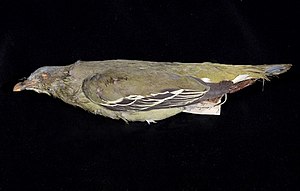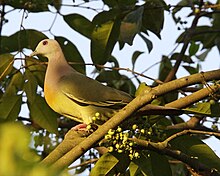Flores green pigeon
| Flores green pigeon | ||||||||||
|---|---|---|---|---|---|---|---|---|---|---|

Flores green pigeon ( Treron floris ) |
||||||||||
| Systematics | ||||||||||
|
||||||||||
| Scientific name | ||||||||||
| Treron floris | ||||||||||
| Wallace , 1863 |
The Flores green pigeon ( Treron floris ), also spelled Flores green pigeon , is a species of pigeon bird that is closely related to the thick-billed green pigeon and is very similar to it. It is an endemic species of the Lesser Sunda Islands .
Like many species whose distribution is limited to a few islands, the Flores green pigeon is also endangered. The population situation of the thick-billed green pigeon is indicated accordingly by the IUCN as vulnerable .
Appearance
The Flores green pigeon reaches a body length of 29 centimeters. It is a medium-sized, compactly built pigeon that is slightly larger than a laughing pigeon . The tail is between 8.1 and 8.6 centimeters. The beak is between 1.7 and 1.9 centimeters long. The sexual dimorphism is less pronounced than in many other species from the genus of green pigeons.
In the male, the forehead and reins are ash gray and merge into a darker gray on the crown and in the neck. The rear neck is dull gray-green. The small wing-coverts are dark olive-colored, the upper row of feathers of the middle wing-coverts are dark olive-colored with broad lemon-yellow hems on the outer flags. The large wing covers are also olive-colored, the hems on the outer flags are pale yellow. The hem is widest at the tip of the feathers. The wings of the hand are black. Freshly molted Flores green pigeons have narrow white feather edges on them. The back is dark olive and lightens towards the rump. The upper tail-coverts and the middle tail feathers. The outer tail feathers are ash gray with a narrow black transverse band in the front center.
The chin and throat are bright green-yellow, the tone of the plumage turns into a darker olive green on the ear covers, neck and chest. The belly is apple green, the flanks are dark olive green. On the back of the abdomen, numerous feathers have white hems or cream-colored feather tips. The short under tail coverts are dark olive green with a cream-colored tip, the long under tail coverts are light isabel with dark spots in the middle. The featherless eye ring is greenish and is hardly noticeable when observing in the field because it has the same tone as the surrounding plumage. The iris is light brown. The base of the beak is greenish gray and lightens to a yellowish to white-greenish tone towards the tip of the beak. The feet and legs are pink.
The females largely correspond to the males in their body plumage. In the males, however, the olive-colored coat is overlaid with brown-violet, while this does not occur in the females.
Possible confusion

In the distribution area of the Flores green pigeon, the spring pigeon also occurs on the islands of Lombok and Sumbawa , which also belongs to the green pigeons and has a similar body plumage. It differs from the Flores green pigeon in that its tail feathers are colored differently: the middle pair of tail feathers is also gray and the black transverse band that runs over the tail feathers is much wider in this species.
Distribution area
The Flores green pigeon is an island end with the Lesser Sunda Islands , a group of islands in the Malay Archipelago . The archipelago consists of six larger and numerous small islands, which are located east of Java . Together they have an area of about 87,700 km² . About twelve million people live on these islands.
In this island world, the Flores green pigeon was originally found on Alor , Lembata (Lomblen), Lombok , Flores , Palu'e , Pantar , Solor , Komodo and Sumbawa and probably also on a number of the smaller islands. The Flores green pigeon was probably never a common species, but it has now disappeared on several of the islands. Sightings on Lomblen and Solor date back to the 19th century, on Lombok it was observed in 1909. It is still represented on Sumbawa and Alor today. However, it is an extremely rare bird there. On Flores it occurs a little more numerous, especially in the interior of the island.
The Flores green pigeon is basically a forest pigeon. However, it is also increasingly observed in open terrain if there are still individual forest groves and remnants of monsoon forests there. The altitude distribution of this pigeon species ranges from the lowlands to altitudes of 800 meters.
Way of life
The Flores green pigeon usually occurs in pairs. Occasionally, however, there are groups of more than 20 individuals on fruit-bearing trees. The diet consists of fruits. Nothing is known about the reproductive biology of this species.
literature
- David Gibbs, Eustace Barnes and John Cox: Pigeons and Doves - A Guide to the Pigeons and Doves of the World . Pica Press, Sussex 2001, ISBN 90-74345-26-3 .
- Gerhard Rösler: The wild pigeons of the earth - free living, keeping and breeding . M. & H. Schaper Verlag, Alfeld-Hannover 1996, ISBN 3-7944-0184-0 .
Web links
- Treron floris in the Red List of Threatened Species of the IUCN 2012. Posted by: BirdLife International, 2012. Accessed November 12, 2016th
- Call of the Flores green pigeon on Xeno-Canto
